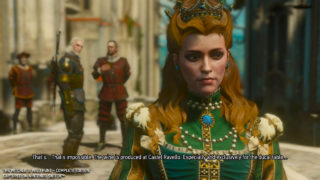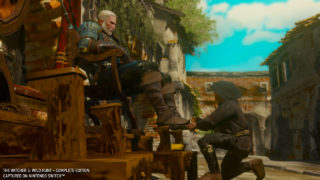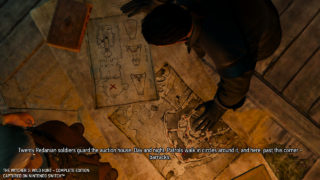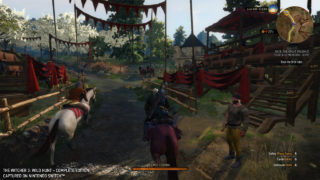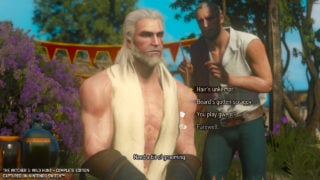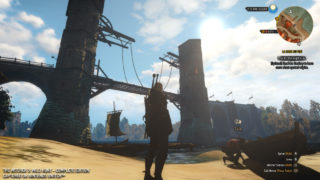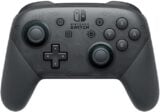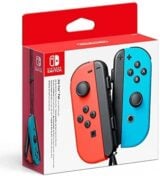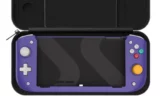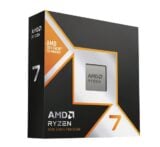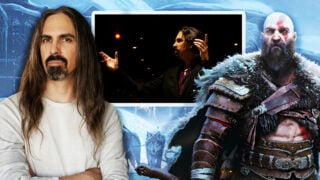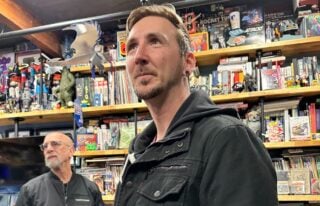The secrets of Witcher 3’s lavish Switch port
CD Projekt Red shares Wild Hunt’s tech specs

Not too long ago you might have thought that getting CD Projekt Red’s epic RPG The Witcher 3: Wild Hunt to run on Nintendo Switch was almost impossible.
However, not only is it running and looking great on the portable hybrid, but it’s entirely contained within a single game card, DLC, expansions and all.
Announced during the E3 2019 Nintendo Direct, The Witcher 3 Nintendo Switch port is being developed by Saber Interactive “in close cooperation” with CD Projekt Red, for release on October 15, 2019.
The RPG was first released for PlayStation 4, Xbox One and PC in 2015, so it was a surprise to some that it was able to be ported to Nintendo’s comparatively less powerful console.
Ahead of the game’s release, VGC met with Piotr Chrzanowski, a senior producer at CD Projekt Red, to discuss the Switch port’s technical secrets.
The game is looking very impressive on Switch. How do you think it ranks among other high-end ports to the platform?
That’s a tough question. I don’t really want to compare it to other ports. All I can say is that we are proud of what we’ve achieved and in the end customers will decide for themselves. We’re very happy how the game looks and plays on Switch and we still have time to make some tweaks.
What kind of technical changes did you need to make in order to get The Witcher 3 running on Switch?
It’s a recurring theme in the conversations I’ve had with the media… you kind of need to see it to believe that it’s there. We made a lot of changes. We had to optimise the game for both the GPU, the CPU, the memory constraints… there was a lot to deal with. A lot of the changes we made are under the hood, because they’re things we had to adjust to the limitations of the hardware.
For example we had 3.5GB memory on the Switch, so the textures had to be compressed in order to fit in the memory. We managed to keep all the effects including the rendering effects that we wanted to have, but of course we had to change the draw distance a little bit.
It’s not hugely noticeable, but if you compare it to PS4 you’ll notice that on the characters we removed 20% of draw distance, but it’s not something you would notice unless you were being told. The same goes for the foliage and the shadows: we simplified the shadows and there are more shadow cascades on PS4 and Xbox One than we have on Switch, but this is not something you’ll recognise just by playing. We’ve also recompressed the cut-scenes to make sure that everything fits on the 32GB cartridge.
How did you manage to fit everything on the one game card?
We looked for efficiency wherever we could. One thing was compressing the textures and because of the resolution they were scaled down a bit. We made some changes to the audio system as well, while the cut-scenes are only 720p, which is the target resolution for the game. So all in all, those things allowed us to put all the game, the DLC and the expansion packs on the game card.
What about in terms of raw game geometry? Did you have to change the size of any of the environments to meet your performance targets?
We had some areas in the game that were demanding from a performance perspective, but those were the same areas that were demanding on PS4 or PC. So our experience building the game for other platforms allowed us to properly plan for those.
Is there much difference between docked and portable modes?
You get a boost in resolution size, because then we are aiming towards 540 x 720, but beyond that no – both modes are quite similar.
What was the biggest challenge in squeezing the game on to Switch?
It’s difficult to choose one. Really it was all about balancing the performance we wanted to achieve, the quality level and all the constraints around it. We wanted to have a game that would be the same game as the PS4 version but running in the 30fps area. So we needed to balance a lot of areas in order to do that.
How significant was Saber Ineractive’s role in the port? It’s obviously a very experienced studio.
We were split in a way that allowed us to manage production, provide guidance and tap into the knowledge that we had at the studio from the people that actually created The Witcher 3. That’s how we organised on our side, but Saber’s role was basically the execution of it.
“We learned about the Switch Lite during development, but as the hardware isn’t really different all the preparations we made for the standard Switch were fine for Lite.”
Were you aware of Switch Lite and the updated core model when you were creating the port? Did that factor into your plans?
Hardware wise in terms of specification those consoles are the same, so the performance will be the same. As far as I’m aware, Lite is the same hardware but with a smaller screen size with the same resolution, while the newer Switch is more power efficient. So the game will run for around 2.5 hours on the first generation Switch and a bit longer on the others.
We learned about the Switch Lite during development, but as the hardware isn’t really different all the preparations we made for the standard Switch were fine for Lite. So there’s nothing specific we had to do.
Finally, does your work porting The Witcher 3 to Switch give you a good foundation for future projects on the platform?
From the perspective or understanding the Switch ecosystem and how the hardware works, definitely. That was a huge gain in having this project. How that affects our future plans I can’t really say.


